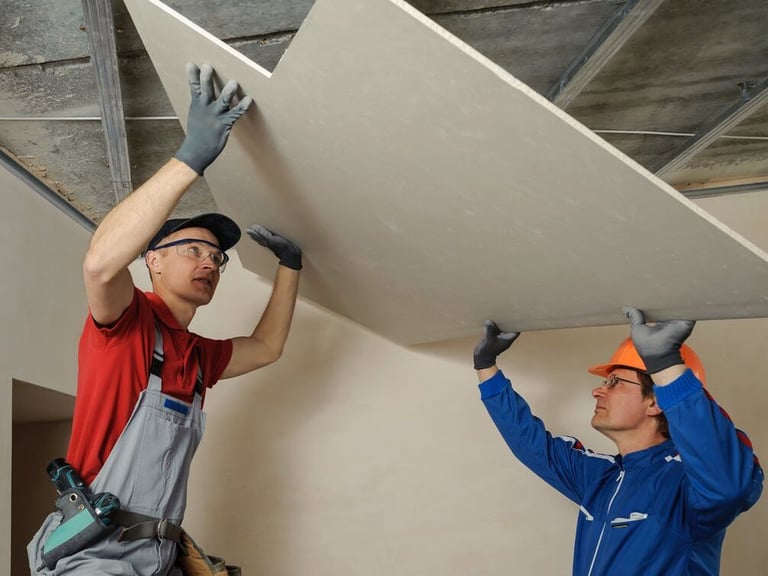CALL TODAY! → (321) 239-5083
The Importance of Professional Sheetrock Installation for New Construction and Remodeling Projects
Strong, straight, and built to last. Find out what makes expert Sheetrock installation essential for remodeling and new construction projects in Florida.
7/1/20254 min read


Understanding Sheetrock Installation
Sheetrock installation is a fundamental aspect of both new construction and remodeling projects, serving as the primary material for constructing interior walls and ceilings. Sheetrock, also known as drywall or gypsum board, consists of a core of gypsum plaster sandwiched between two sheets of heavy paper. Its versatility and ease of installation make it a preferred choice for various settings, including residential homes and commercial buildings.
There are different types of sheetrock available, each tailored for specific applications. For instance, standard sheetrock is commonly used in areas that do not encounter significant moisture. Conversely, moisture-resistant variants, often referred to as green board, are ideal for spaces such as bathrooms and kitchens, where humidity levels are elevated. For high-traffic areas or locations prone to impact damage, such as schools or offices, specialty options like impact-resistant sheetrock can enhance durability and extend the lifespan of walls.
The significance of proper sheetrock installation techniques cannot be overstated. Quality installation influences the overall durability of the structure, ensuring that walls and ceilings can withstand the test of time and resist common issues such as sagging or cracking. Additionally, meticulous installation enhances the aesthetic appeal of a space, providing a smooth, finished look that can be easily painted or textured. Expertly installed sheetrock contributes to sound insulation and energy efficiency, enhancing comfort within the environment. Denser sheetrock options also offer improved fire resistance, making them suitable for commercial applications.
In summary, understanding sheetrock installation is crucial for successfully executing construction and remodeling projects. Selecting the appropriate type of sheetrock and employing proper techniques not only leads to durable and visually appealing finishes but also promotes safety and functionality in both residential and commercial settings.
The Impact of Installation Quality on Durability and Safety
The quality of sheetrock installation plays a crucial role in ensuring not only the durability of a building but also its overall safety. When installed properly, sheetrock acts as a reliable barrier, supporting structural integrity and enhancing fire resistance. Conversely, subpar installation can lead to a myriad of problems, undermining the very purposes it is intended to serve.
One of the most common issues arising from inadequate installation is the development of cracks in the drywall. These cracks not only detract from the aesthetic appeal of walls but can also indicate underlying structural issues. In some cases, poorly hung sheetrock can settle unevenly, leading to further misalignments and potential failure of the wall system.
Moreover, inferior installation techniques can create conditions conducive to mold growth. Gaps, improper sealing, and moisture retention are frequent outcomes of low-quality workmanship. Mold can pose serious health risks to occupants, necessitating expensive remediation efforts. This highlights the imperative need for experienced professionals who understand how to mitigate such risks through meticulous installation practices.
Structural weakness is another concern associated with poor installation. When sheetrock is not secured appropriately, it can compromise the entire framing system, potentially leading to collapse in extreme cases. A licensed team is trained to adhere to industry standards and building codes, which serve as crucial guidelines for installation practices. Compliance with these standards ensures that the finished product is not only durable but also aligned with safety regulations.
In summary, the professionalism and expertise of the installation team significantly impact the durability and safety of any construction or remodeling project. Selecting a licensed and experienced crew is essential for achieving high-quality results, thereby safeguarding the structure against future issues.
Choosing the Right Professionals for Your Project
When embarking on a new construction or remodeling project, selecting the right professionals for sheetrock installation is crucial for ensuring quality work and long-term satisfaction. Hiring licensed, experienced contractors rather than general laborers can make a significant difference in the outcome of your project. Specifically, seasoned commercial drywall contractors or residential drywall installation specialists bring a level of expertise that is often unmatched, allowing them to handle challenges that may arise during the installation process more effectively.
One of the primary benefits of working with professionals in the drywall installation sector is their comprehensive understanding of materials, techniques, and building codes. Licensed contractors are typically trained to understand the specific requirements of different projects and can offer insights that might not be evident to inexperienced workers. Additionally, professionals are familiar with local regulations and safety protocols, reducing the likelihood of issues during inspections.
When selecting a team for your sheetrock project, there are several key factors to consider. First, examine their credentials and ensure they are properly licensed and insured. This protects you from potential liabilities and guarantees that the work will meet industry standards. Next, look for reviews and testimonials from previous clients, which can provide insight into their reliability, work quality, and professionalism. A portfolio of past projects is also an important aspect to consider, as it showcases their proficiency and range in handling different types of installations, whether it be simple residential settings or complex commercial environments.
In summary, choosing the right professionals for sheetrock installation involves careful evaluation of credentials, reviews, and previous work. By enlisting the help of experienced contractors, you can ensure a seamless installation process that meets your project's specific needs and contributes to its overall success.
What to Expect During the Sheetrock Installation Process
When embarking on a sheetrock installation for new construction or remodeling projects, homeowners can anticipate a well-defined process. Typically, the installation timeline is segmented into several stages, including measuring, cutting, hanging, finishing, and painting. On average, a residential installation can take anywhere from a few days to a week, depending on the scale of the project and the number of rooms involved. The team will initially assess the space, measuring and cutting the sheetrock to fit each wall and ceiling area.
During this process, it is essential for homeowners to be prepared for some potential disruptions. Expect increased noise levels due to tools being operated and the presence of construction personnel. It is advisable to arrange alternative accommodations for pets and, if feasible, for family members. Additionally, proper planning should include clearing the installation area of personal belongings and furniture to facilitate a smooth transition for the installers.
Effective communication with the installation team is crucial. Homeowners should express any specific preferences or concerns before the project begins. Establishing a clear line of communication not only helps in conveying expectations but also in addressing any unexpected issues that may arise during the project. For instance, if a concern is identified, such as a discrepancy in measurements or damaged materials, timely communication ensures that the installation proceeds smoothly, without unduly affecting the overall timeline.
In preparation, homeowners might also consider preparing for a post-installation cleanup, as there may be dust and debris from the installation process. By understanding what to expect during the sheetrock installation, clients can navigate the experience more smoothly, resulting in a satisfying outcome for their construction or remodeling endeavors.
FOLLOW US ON SOCIAL MEDIA
SUBSCRIBE TO OUR NEWSLETTER
CALL:
HOURS:
Available 24/7
COPYRIGHT © 2025 KING DRYWALL SERVICES LLC.


